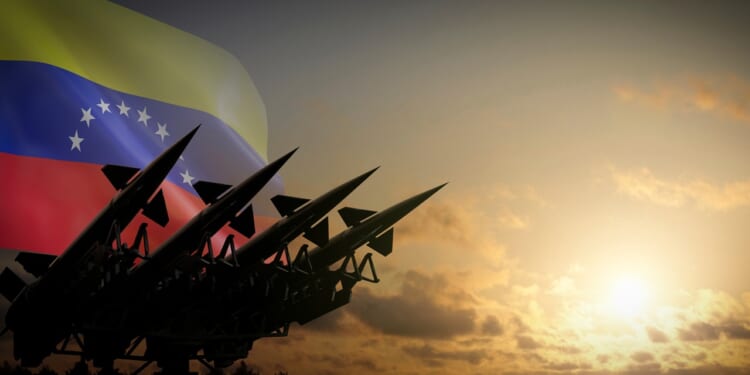Venezuela has an arsenal of Russian-supplied supersonic missiles, which could pose problems for the US Navy during any future conflict with the Maduro regime.
With the Trump administration’s campaign against Venezuela reaching new levels of hostility, the assumption is that the US military will easily defeat any resistance that the Venezuelans put up against the Americans. This might be true. Indeed, on paper, the US military outstrips the Venezuelan military in almost every way. Yet we are not living in a conventional age. We are in the era of unconventional, asymmetrical warfare.
This is a fact that Venezuelan leader, Nicolas Maduro himself has acknowledged. And he’s been hinting publicly that Venezuela has greater capabilities—courtesy of the Russians—than what the Americans are willing to acknowledge. In fact, a recent assessment by The War Zone, a trade publication, argues that Venezuela’s Russian-made supersonic missiles—the Kh-31A (NATO codename “AS-17 Krypton”)—poses a real threat to warships belonging to the United States Navy, which are currently parked off Venezuela’s coast.
Understanding Venezuela’s Kh-31A Anti-Ship Missile
The Kh-31 missile family includes both an anti-radiation version (Kh-31P) along with an anti-ship version (Kh-31A). The Kh-31A is the one that experts are warning the Trump administration must keep an eye on.
A supersonic missile, the Kh-31A uses ramjet propulsion (after an initial rocket boost) to achieve speeds up to Mach 3.5 at high altitude or Mach 1.8 at sea-level. It has a maximum range of around 31 miles, though there also exists a longer-range variant, the Kh-31AD, with an effective range between 75 to 100 miles. It is not yet clear that Venezuela possesses that longer-range variant. But US forces should assume that it does, given the close—and still growing—military ties between Caracas and Moscow. And those US Navy warships are operating within the range of both the Kh-31A and the more advanced Kh-31AD.
Yes, US warships have sophisticated air defenses. But those defenses are not foolproof. And the employment of supersonic weapons, like the Kh-31A by the Venezuelan Armed Forces, drastically reduces reaction times.
US Navy Warships May Not Be Ready for a Surprise Attack
Already, Venezuelan F-16 warplanes have surprised US Navy warships off the coast of Venezuela by getting close enough to those American warships to buzz them. If they had decided to attack, it would have been difficult to defend against.
What’s more, the Navy’s systems are optimized for known threat envelopes, not necessarily more congested littoral zones in which supersonic anti-ship missiles launched from fighters operating off nearby terrain are deployed. Even if Venezuela’s missile arsenal is modest, a single successful hit on a US destroyer or amphibious ship would be a major victory for Caracas—and a massive embarrassment for the braggadocios Trump administration. Indeed, it doesn’t take many missiles in Venezuela’s arsenal to have a deterrent effect on US forces that are looking for a quick, relatively clean victory over Maduro.
Still, despite Maduro’s puffery, the Venezuelan Armed Forces are truly second-rate. Whether it be poorly maintaining its limited fleet of old F-16s and Su-30s, or skimping on other key weapon systems, Venezuela has a reputation for letting its already limited capabilities wither due to neglect.
Don’t Underestimate Maduro’s Desperation
Maduro’s regime—possibly even his life, given the recent $50 million US bounty on his head—is on the line. Therefore, Maduro will fight like any cornered animal would: desperately and viciously. It is very possible that he has spent the last several months that this crisis has escalated ensuring he has at least some ace-in-the-hole. And these systems are distributed across the territory he controls, meaning that they will be harder to destroy by US airpower.
Further, with US-Russian relations reaching a nadir on the matter of Ukraine, Moscow is now incentivized to provide maximum military support to Venezuela’s embattled regime. The US must take the anti-ship threat very seriously, especially as it prepares for what Trump has already implied will be ground strikes in Venezuela.
About the Author: Brandon J. Weichert
Brandon J. Weichert is a senior national security editor at The National Interest. Recently, Weichert became the host of The National Security Hour on America Outloud News and iHeartRadio, where he discusses national security policy every Wednesday at 8pm Eastern. He is also a contributor at Popular Mechanics and has consulted regularly with various government institutions and private organizations on geopolitical issues. Weichert’s writings have appeared in multiple publications, including The Washington Times, National Review, The American Spectator, MSN, The Asia Times, and others. His books include Winning Space: How America Remains a Superpower, Biohacked: China’s Race to Control Life, and The Shadow War: Iran’s Quest for Supremacy. His newest book, A Disaster of Our Own Making: How the West Lost Ukraine is available for purchase wherever books are sold. He can be followed via Twitter @WeTheBrandon.
Image: Shutterstock / PX Media.


















